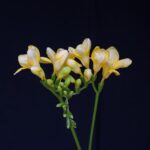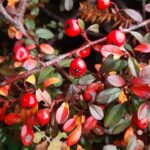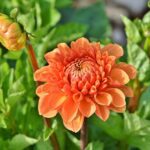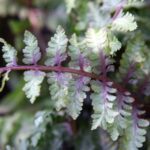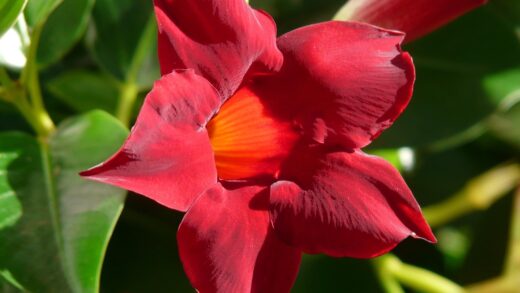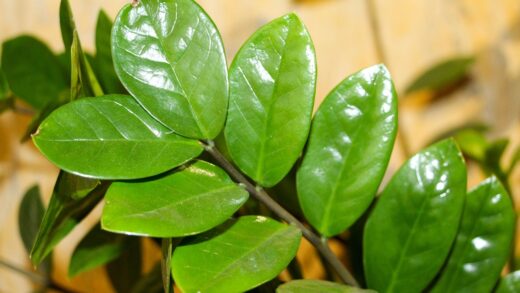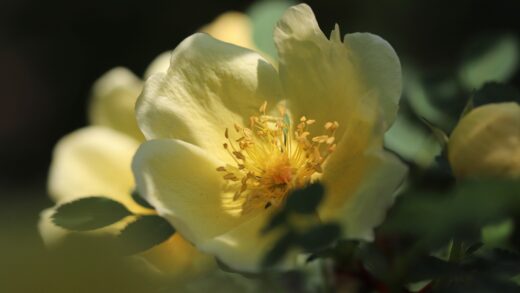The Abyssinian gladiolus, also known as the fragrant gladiolus or Acidanthera, is a truly charming and elegant plant whose snow-white, star-shaped flowers with a maroon centre exude a delicate fragrance in the late summer and early autumn garden. To enjoy this beauty year after year, and for your plant to remain healthy and strong, proper care is essential, of which expert pruning and cutting back form an integral part. Although it is not among the plants requiring classic pruning, such as roses or fruit trees, the application of certain cutting techniques is crucial for abundant flowering, disease prevention, and the development of the corms (more precisely, corm-like modified stems) for the following year. Learning these practices is not complicated, but it requires attention and amply rewards you in the form of healthy, fragrant flowers adorning your garden.
The life cycle of the Abyssinian gladiolus begins in spring with the planting of the corms. Throughout the summer, the plant develops its long, sword-shaped leaves and the characteristic flower stalk where the buds are neatly arranged. Flowering typically occurs from August to September, sometimes extending into October. Following this vibrant display, the plant initiates the process of drawing nutrients from its leaves back into the corm. This is a vital stage as the plant prepares for its winter dormancy period, and understanding this cycle is key to proper care.
What exactly do we mean by “pruning” and “cutting back” when discussing the Abyssinian gladiolus? For this particular plant, these terms primarily refer to a few specific actions: removing spent flowers to encourage further blooming and plant vigor, managing the flower stalks once flowering has ceased, and cutting back the foliage after it has naturally died down at the end of the growing season. Unlike the structural pruning you might perform on shrubs or trees, these actions are more about plant hygiene and energy management. These targeted cuts help maintain the plant’s health and prepare it for a robust return the following year.
Correctly performed cutting operations bring numerous benefits to your Abyssinian gladiolus. Deadheading, or the removal of spent flowers, prevents the plant from expending energy on seed production, instead directing those resources towards strengthening the corm for future growth. This practice not only leads to more vigorous plants and richer flowering in subsequent seasons but also keeps your garden looking tidy. Furthermore, removing old and browning foliage at the appropriate time helps to reduce the chances of diseases and pests overwintering near your plants, contributing significantly to their overall vitality and longevity.
Post-flowering tasks: removing spent flowers
Once the individual flowers on the Abyssinian gladiolus stalk begin to fade and lose their vibrancy, it is important to remove them promptly. This practice, commonly known as deadheading, serves a crucial purpose in the plant’s energy management. By removing the spent blooms, you prevent the plant from diverting its resources into seed production. Instead, this energy can be channeled back into the corm, which is vital for nourishing next year’s growth and ensuring a spectacular display of flowers. Neglecting this task can lead to weaker corms and a less impressive floral show in the subsequent season.
More articles on this topic
The technique for deadheading Abyssinian gladiolus is straightforward but requires a gentle touch to avoid harming the rest of the plant. As each flower wilts, carefully snap or cut it off at its base, where it meets the main flower stalk. Be cautious not to damage any remaining unopened buds on the same stalk or any adjacent plants that are still in bloom. Once all the flowers on a particular stalk have finished blooming and have been removed, the entire stalk itself no longer serves a productive purpose for that season’s flowering.
After all the individual florets on a flower stalk have faded and been removed, the stalk itself can be cut down. This is because the old stalk will not produce any more flowers in the current season. Allowing it to remain can unnecessarily drain energy from the plant that could otherwise be used for corm development. Use clean, sharp pruning shears or a knife to cut the stalk близко to the base of the plant, emerging from amongst the leaves. This not only aids the plant’s energy conservation but also maintains a neater appearance in your garden beds.
For these deadheading and stalk removal tasks, it is always best to use clean and sharp tools. A good pair of secateurs, floral snips, or even a sharp knife will ensure clean cuts and minimize damage to the plant tissue, which can be an entry point for diseases. It is a good practice to disinfect your tools before you begin and after you finish, especially if you are moving between different plants, to prevent any potential spread of pathogens. For removing individual spent florets, sometimes careful pinching with your fingers can suffice, provided you do so gently.
The role of foliage and timing the cutback
After the Abyssinian gladiolus has finished its spectacular flowering display, the leaves take on an extremely important role in the plant’s life cycle and should not be removed prematurely under any circumstances. These green, sword-like leaves are responsible for photosynthesis. Through this process, they convert sunlight into a vital energy source – sugars – which are then transported down and stored in the corm. This stored energy is absolutely crucial for the plant to survive the winter dormancy and to fuel its emergence, growth, and flowering in the following spring and summer. This critical period of energy production and storage can last for several weeks, or even a couple of months, after the last flower has faded.
More articles on this topic
The most reliable indicator that the foliage of your Abyssinian gladiolus is ready to be cut back is its natural change in color and condition. You will observe the leaves gradually transitioning from green to yellow, and eventually to brown, as they begin to wither. This change signals that the process of photosynthesis has ceased and that the plant has successfully transported the majority of the valuable nutrients and energy reserves from the leaves down into the corm for winter storage. This typically occurs in the late summer or early autumn months, depending on your specific climate and the plant’s growing conditions; patience during this phase is key.
If you cut back the foliage too early, while it is still green and actively photosynthesizing, you can cause significant harm to the plant’s future prospects. The corm will not have had sufficient time to accumulate the necessary energy reserves. Consequently, the plant may be noticeably weaker in the following growing season, producing fewer flowers, smaller blooms, or in the most severe cases, it might not flower at all. Furthermore, an underdeveloped and undernourished corm is often more susceptible to winter damage from cold temperatures and can also be more vulnerable to various diseases, even if you provide otherwise adequate winter protection.
Therefore, it is important to resist the urge to tidy up your garden beds prematurely by cutting down the green, though perhaps slightly untidy-looking, leaves of the Abyssinian gladiolus. Even as the season progresses and the foliage may start to look a bit weathered or less aesthetically pleasing, remind yourself that this is a natural and essential part of the plant’s life cycle. The plant’s long-term health and its ability to produce those beautiful, fragrant blooms year after year depend heavily on allowing the foliage to die back naturally, fulfilling its energy-producing role to completion.
Technique for cutting back foliage
Once the foliage of the Abyssinian gladiolus has significantly yellowed or browned, indicating that it has completed its task of nourishing the corm, it is the appropriate time to cut it back. At this stage, the leaves have fulfilled their purpose for the season, and most of the essential nutrients have been successfully translocated to the corm for storage over the dormant period. Removing the dead or dying foliage is beneficial not only for maintaining a tidy appearance in your garden but also because decaying plant matter can sometimes harbor pests or fungal spores over the winter, potentially leading to problems in the next growing season.
When cutting back the foliage, the general recommendation is to make the cuts a few inches above the soil line. A height of approximately 2 to 4 inches (or 5 to 10 centimeters) is typical. Leaving a short stub can serve as a helpful marker to locate the corms later, especially if you plan on lifting them for winter storage in colder climates. If you intend to leave the corms in the ground to overwinter (which is feasible in milder regions with adequate protection), cutting back the foliage still contributes to the overall cleanliness of the area and makes applying a winter mulch easier.
For the task of cutting back the foliage, a pair of sharp, clean pruning shears or garden snips is the most suitable tool. As with any pruning or cutting task in the garden, ensuring your tools are clean and sharp is paramount. Sharp blades make clean cuts, which minimizes damage to any remaining plant tissue and reduces the risk of disease entry, even when dealing декоративни with mostly dead foliage. Dull tools can crush or tear stems, creating ragged wounds that are more susceptible to infection. Remember to clean your tools after use as well.
The disposal of the cut foliage is another important consideration for good garden hygiene. If the leaves appear healthy and show no signs of disease, such as fungal spots or mildew, they can be safely added to your compost pile. There, they will break down and contribute valuable organic matter back to your garden’s ecosystem. However, if you notice any signs of disease on the foliage, it is best to dispose of it in your green waste collection or burn it (if local regulations permit) rather than composting it. This will help prevent the potential spread of pathogens within your garden.
Special aspects and considerations
The Abyssinian gladiolus is an excellent choice for cut flowers, as its fragrant blooms arranged on long, elegant stalks are exceptionally decorative in a vase. If you wish to cut them for indoor display, the best time to do so is when the first one or two florets декоративни on the spike have just opened, while the remaining buds are still showing color but are not yet fully open. This will ensure that the flowers continue to open sequentially indoors, prolonging your enjoyment. When cutting, use a sharp knife or clean secateurs and aim to take as long a stem as possible, but critically, always leave at least two to four leaves декоративни декоративни on the plant in the garden to help the corm develop and store energy for the next season’s growth and flowering.
Your local climate will significantly influence how you manage the cutting back process and winter care for Abyssinian gladiolus. In colder regions where winter frosts pose a serious threat to the corms if left in the ground, they typically need to be lifted in the autumn after the foliage has died back and then stored in a frost-free location for the winter. In such cases, the timing of cutting back the foliage is often closely tied to the first anticipated hard frosts. You should allow the leaves to nourish the corm for as long as possible but complete the cutting and lifting декоративни before severe cold sets in. In milder climates, where the corms can be left in the ground with adequate winter protection (such as a thick layer of mulch), cutting back the dead foliage is still important for garden tidiness and disease prevention.
Throughout the growing season and particularly at the time of cutting back, always be observant for any signs of disease or pest infestation on your Abyssinian gladiolus plants. If you notice any fungal spots, unusual discolorations, or the presence of pests on the leaves or stems, it is crucial to take appropriate action декоративни promptly. Removing and destroying affected plant parts декоративни immediately can prevent the problem from spreading to other plants. When dealing with potentially infected plants, it is especially important to disinfect your pruning tools thoroughly after use on each plant to avoid inadvertently transferring pathogens to healthy specimens. This simple hygiene step can play a significant role in maintaining the overall health of your garden.
If your gardening objective includes collecting seeds from your Abyssinian gladiolus, perhaps for a ugmenting new plants or for sharing, then you obviously should not deadhead the spent flowers. In this scenario, you will need to allow the flowers to fade naturally and for the seed pods to develop and mature декоративни fully on the plant. Once the seed pods have dried декоративни and are beginning to split open, the stalks декоративни bearing the pods can be cut and brought indoors to dry further before you extract the seeds. This approach is quite different from the goal of maximizing the corm’s energy reserves for vegetative propagation and ensuring the most robust flowering display the following year, and thus your cutting strategy will differ accordingly.
Care after cutting back and preparation for the next season
After you have cut back the foliage of your Abyssinian gladiolus in the autumn, some follow-up care might be necessary, particularly if you intend to leave the corms in the ground to overwinter. In regions with milder climates where extreme winter frosts are not a regular occurrence, it is a good practice to provide the corms with a protective layer of mulch. Once the foliage is cut back, apply a generous layer, typically 4 to 6 inches (10 to 15 cm) thick, of organic material such as shredded leaves, straw, well-rotted compost, or bark chippings over the area where the corms are planted. This mulch layer will help insulate the soil, protecting the corms from cold temperatures and fluctuating soil moisture levels, thereby aiding their successful overwintering.
In colder climate zones, where winter temperatures regularly drop significantly and pose a threat to the survival of corms left in the ground, it is standard practice to lift them for winter storage. This should be done after the foliage has naturally died back and been cut down. Use a garden fork to carefully dig around and under the corms, taking care not to damage them. Once lifted, gently remove any adhering soil and the remaining stubs of the cut stems. The corms then need to be “cured” or dried for a few weeks in a warm, dry, and well-ventilated location, such as a garden shed, an airy garage, or a covered porch. This curing process helps to toughen their skins and reduces the risk of rot during storage.
The dormant period is an absolutely essential phase in the life cycle of the Abyssinian gladiolus. Regardless of whether the corms are left in the ground under a protective mulch or are lifted and stored indoors, this resting phase prepares them for the next cycle of growth and flowering. During storage, it is crucial to keep the corms in a cool, dry, and frost-free environment. Avoid conditions of high humidity or excessive moisture, as this can easily lead to fungal diseases and rotting. Storing them in paper bags, mesh sacks, or trays filled with a dry medium like peat moss, vermiculite, or sand can help maintain optimal conditions.
The care and actions you take during the cutting back phase in autumn, as well as the subsequent winter care, directly influence the plant’s performance in the following spring and summer. Allowing the foliage to mature декоративни fully, cutting it back at the right time, and providing appropriate winter protection for the corms are all crucial investments in future displays of beautiful and fragrant blooms. These seemingly simple steps are key to the successful cultivation of Abyssinian gladiolus, ensuring that this special plant can be a highlight and a source of pride in your garden year after year.







